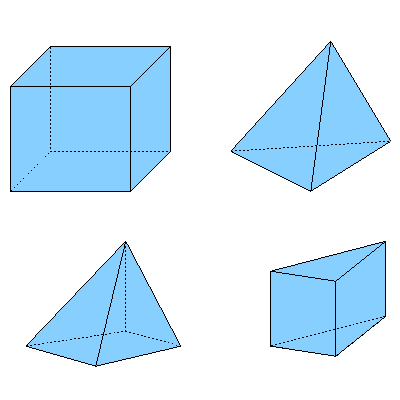Dimension (2D, 3D or 2.5D)
From CFD-Wiki
Depending upon the analysis type and solver requirements, meshes generated could be 2-dimensional (2D) or 3-dimensional (3D).
For a 2D mesh, all mesh nodes lie in a given plane. In most cases, 2D mesh nodes lie in the XY plane, but can also be confined to another Cartesian or user defined plane. Most popular 2D mesh elements are quadrilaterals (also known as quads) and triangles (tris), shown below.
3D mesh nodes are not constrained to lie in a single plane. Most popular 3D mesh elements are hexahedra (also known as hexes or hex elements), tetrahedra (tets), square pyramids (pyramids) and extruded triangles (wedges or triangular prisms), shown below. It is worth noting that all these elements are bounded by faces belonging to the above mentioned 2D elements. Some of the current solvers also support polyhedral elements, which can be bounded by any number and types of faces.
Since all 3D elements are bounded by 2D elements, it is obvious that 3D meshes have exposed 2D elements at boundaries. Most of the meshing packages and solvers prefer to club exposed elements together in what is known as a surface mesh (for the purposes of applying boundary conditions, rendering meshed domains and visualizing results). A surface mesh does not have to be 2D, since volume meshes may conform to domains with non-planar boundaries. Many meshing algorithms start by meshing bounding surfaces of a domain before filling the interior with mesh nodes (such algorithms are also known as boundary to interior algorithms). For such algorithms, generation of good quality surface meshes is of prime importance, and much research has been done in the field of efficient and good quality surface mesh generation. Since surface meshes are geometrically somewhere between 2D and 3D meshes, they are also sometimes known as 2.5D meshes.


